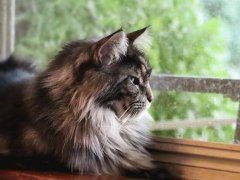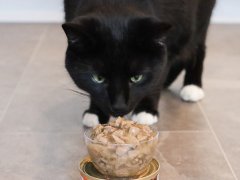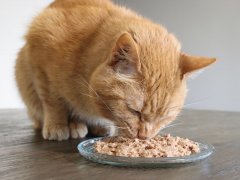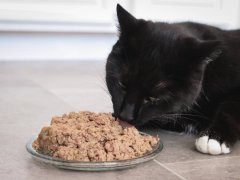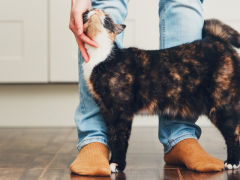
Bill Roque / Shutterstock.com
Feeding a pregnant cat might seem as simple as giving her a little more food, but ensuring she receives the right nutrition during this critical time is essential for both her health and the health of her kittens. Just like humans, a cat’s body undergoes significant changes during pregnancy, and her dietary needs shift accordingly. In this article, we’ll walk you through why pregnant cats need special food, what kind of food is best, and how much to feed her to keep both queen and kittens thriving.
Do Pregnant Cats Need Special Food?
Pregnancy, although exciting and miraculous, is also pretty hard work! Growing kittens takes a lot of energy, and pregnancy places extra demands on a cat’s body. Over the approximately nine weeks of gestation, a queen (a female cat) undergoes dramatic physical changes: her weight increases by 30-50%, her energy requirements rise, and her body requires larger amounts of specific nutrients to support the growth and development of her kittens.
A pregnant cat needs more calories, protein, vitamins, and minerals to support:
- Fetal development: Growing kittens require essential nutrients to form healthy bones, organs, and immune systems.
- Milk production: After birth, the queen will need additional nutritional reserves to produce enough milk for her litter of offspring.
- Maternal health: Pregnancy and nursing are physically demanding, so it’s vital to keep the queen strong and healthy to avoid complications such as weight loss and lowering of immune function.
Feeding the wrong type of diet, or not providing enough food for their extra requirements, can lead to issues like malnutrition, poor fetal growth, and even complications during labor. On the other hand, providing high-quality, appropriate food can contribute to an easier pregnancy and healthier kittens.
What Type of Food Should I Feed a Pregnant Cat?

Pregnant queens need a diet high in energy, protein, and vital vitamins and minerals to support healthy growth. Kirsten McCarthy / Cats.com
The best food for a pregnant cat is nutrient-dense, high in protein, and formulated to support growth and reproduction.
While adult maintenance cat food may meet basic needs, it typically lacks the calorie and nutrient density required during pregnancy. One of the simplest and most effective strategies to provide the calorific requirement and extra nutrients needed to feed your pregnant cat is to move to a high-quality kitten food.
Kitten formulas are higher in:
- Calories: to support increased energy needs
- Protein: for fetal development and milk production
- Fats: to provide energy and support tissue growth
- Calcium and phosphorus: for developing bones
- Omega-3 fatty acids: like DHA to support brain and eye development in kittens
Not all kitten foods are created equal. Choose a product from a reputable manufacturer that uses high-quality ingredients and has a track record of nutritional research. Look for a food labeled as “complete and balanced” for growth or reproduction by AAFCO (Association of American Feed Control Officials) standards.
When changing your cat onto the kitten food, or whichever pregnancy-appropriate diet you choose, always introduce the new diet gradually over the course of 7-10 days, to prevent tummy upsets.
Is Wet Food or Dry Food Better for Pregnant Cats?
While dry food is convenient and calorie-dense, including wet food in your cat’s diet can help with hydration and may be easier for her to eat as her belly expands. Wet food is also often more palatable, which can be useful if her appetite fluctuates.
Also Read: Wet vs. Dry Cat Food: What’s Better for Cats?
Adding Supplements
Healthy, pregnant cats on a balanced, commercial diet should not need vitamin or mineral supplements. In fact, giving extra supplements can actually do more harm than good. Adding in unnecessary calcium supplements, for example, can interfere with proper bone development or lead to eclampsia during lactation. Always check with your vet before adding any supplements to a cat’s diet.
How Much To Feed a Pregnant Cat

Providing optimal nutrition is important through pregnancy and into lactation. Esin Deniz / Shutterstock.com
A pregnant cat’s appetite typically increases over the course of gestation, and her energy needs can nearly double by the end of pregnancy. Additionally, she may only be able to eat small food portions at a time, so her feeding schedule may need to be adjusted.
Giving set instructions is impossible, as every cat is different. How much to feed depends on her size, the number of kittens she’s carrying, and her activity level.
Feeding Guidelines by Stage of Pregnancy
- Weeks 1–3: Most cats will eat their usual amount of food during the early stages of pregnancy. No major changes are needed yet. This is a good time to transition slowly onto a kitten diet, if you have not already done so.
- Weeks 4–6: This is when fetal growth really begins to accelerate. Start gradually increasing her food intake by around 10–20% per week.
- Weeks 7–9: By this stage, her abdomen will be noticeably larger, and her appetite may peak or fluctuate. Offer smaller, more frequent meals to accommodate her limited stomach space.
Some owners choose to leave dry food out all day during late pregnancy and lactation, especially for underweight or picky eaters. However it’s important to avoid the temptation to overfeed, which can lead to obesity and complicate delivery. Your veterinarian can help you assess your cat’s body condition and make tailored feeding recommendations.
Postpartum Nutrition
Don’t switch your cat’s food immediately after she gives birth. Continue feeding kitten food while she is nursing, as lactation demands even more energy than pregnancy. Once the kittens are weaned, at around 8 weeks old, you can gradually transition her back to her usual adult maintenance food.
